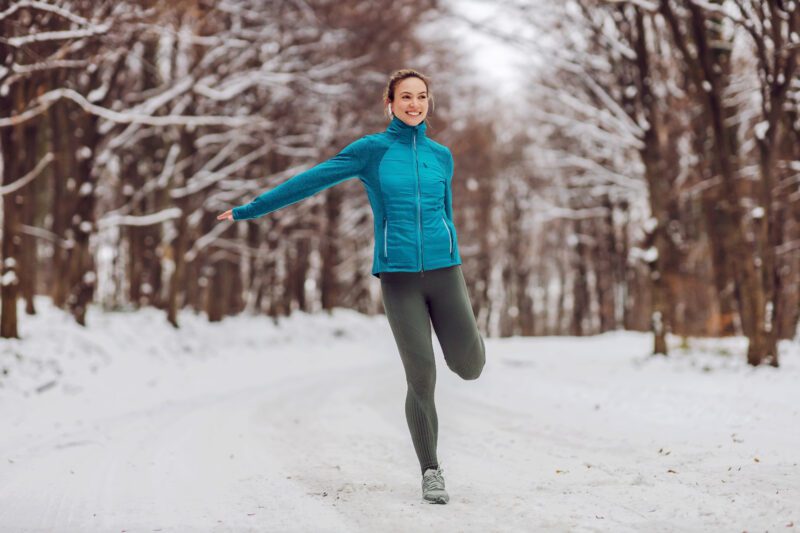
Colder weather means some changes to how we exercise. Of course, it’s harder to motivate yourself to get outside for a run or bike ride when the temperature drops, and the shorter days compress our schedules, but there are changes in your body that affect your ability to exercise too. For many people with arthritis or other joint problems, cold weather brings more complaints of pain.
To stay warm, our bodies narrow blood vessels to reduce blood flow to the skin, and more superficial muscles. That means that there is an increased risk of muscle strains in the cold. There is also an increased strain on the heart because of the narrowed blood vessels.
This isn’t to say that you shouldn’t be active outdoors in the cold, it just means you may have to make a few changes to your routine. Here are a few to consider:
Warm up the right way, even in the cold
A good warm-up is always important, but because of the tendency for joints to be stiffer, and blood flow to muscles to be reduced in the cold, it’s even more important that you do it right this time of year. To start, do something to get your heart rate up a bit, maybe a brisk walk or light jog. Next, follow that up with a dynamic warm-up rather than static stretches. This could include walking or jogging while pulling your knees up high to your chest. Maybe some high kicks in front of you with straight knees to get your hamstrings loosened. A walking lunge with an upper-body twist can get your whole body moving. Cater your warm-up to what you have planned in your workout. If you’re not sure how it should look, ask your physical therapist!
Dress accordingly – layer up!
Dressing in layers allows you to adjust your insulation to your activity level. After you warm-up, you might want to take off a layer to avoid getting too hot during your main activity. You’ll have it there later to put back on when your activity level drops and you start getting too cold.
Don’t forget about the sun either – just because it’s cold doesn’t mean the UV rays are gone. Sunscreen and sunglasses aren’t just for the summer. A lip balm with SPF can protect you not only from the sun but from the wind too.
Hydration is just as important in the cold weather
Drink water before, during, and after your workout. The temperature may be down, but you’ll still sweat and you’ll still lose water vapor in your breath. The drier air in winter lets your sweat evaporate more quickly, so it’s easy to underestimate how much fluid you’ve lost. What does this mean? Hydration is just as important in cold weather as it is in the hot summer months.
Cool Down
When you’re done, don’t rush to get inside and crawl under a blanket. Cool down properly. Keep moving with a walk or another form of active recovery to let your heart rate come down. After exercise is the right place for static stretching. You can also head inside for some foam rolling or self-massage.
The days being shorter and the temperatures being lower don’t mean you’re stuck inside for all of your exercise. If you follow these tips, you can safely keep moving outside. If you’d like a customized warm-up or cool down, or have questions about your exercise routine, your physical therapist is a great person to ask!
*Thank you to the APTA Private Practice Section for providing the content for this blog.
Keep Reading…
WHY AM I LOSING MY BALANCE?
Is it because I am getting older? As we age, our body changes. Our reflexes slow down and our nerve signals are not quite as fast to alert us to make a correction when we lose our balance. Balance is essential to our everyday routine – from getting dressed to taking the dog for a walk, to cooking a meal. Most of the time you don’t have to think about balance – but when you do, it can become frustrating. The feeling of being unsteady can lead to inactivity. Individuals tend to withdraw from their favorite activities or decline invitations due to a fear of falling. The less you do the weaker balance will become and risk for falls will increase. What a vicious cycle!
REDUCE RISK FOR FALLS IN YOUR HOME
There are many modifications and changes that you can make around your home to lower the risk for falls. Here are are a few ideas!
8 EXERCISES TO IMPROVE BALANCE AND STRENGTH
To maintain your balance, the body needs to feel which way you are falling, how to move to correct that balance loss and then move in that direction. All of this happens in an instance so it is important to keep you muscles strong and your balance sharp so the body reacts properly. A fall can lead to fractures, head injuries and wounds. If significant, the injury can turn into hospital stays and months of rehabilitation. So lets get this balance thing under control!
TOP 6 WAYS TO NATURALLY SPEED UP RECOVERY FROM INJURY
The latest research shows the amazing properties of food, proper nutrition and other healthy lifestyle “pillars” as important components related to healing and injury recovery. The relationship of the body systems is one of interconnections; as one system impacts another. An emerging shift in healthcare is recognizing the value of natural influences that provide and support overall health, healing and wellness. Nowadays, we are inundated with advertisements which promise the power of a pill or pharmaceutical to reverse aging or to relieve pain and other symptoms. However, there are numerous reasons and benefits to consider food as a powerful and natural way to improve healing!




